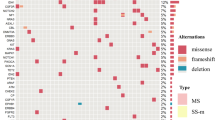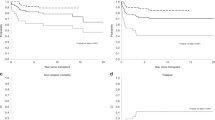Abstract
Langerhans cell histiocytosis (LCH) is a clonal histiocytic neoplasm with various clinical manifestations and heterogeneous prognoses. No standard therapy is available for recurrent/refractory LCH patients. This single-center, single-arm, phase 2 study enrolled 32 patients diagnosed with recurrent/refractory LCH. The TCD regimen (thalidomide 100 mg daily, cyclophosphamide 300 mg/m2 Day 1, 8, 15, and dexamethasone 40 mg Day 1, 8, 15, 22 every 4 weeks) was administered for 12 cycles and thalidomide alone as maintenance for 12 months. The primary endpoint was event-free survival (EFS). Events were defined as progression during or after TCD therapy or death from any cause. After a median follow-up of 22 months (range 5–24 months), no patient died of all causes. The overall response rate was 87.5%, including 18 patients (56.3%) achieving complete remission and 10 patients (31.3%) as partial remission. The estimated 24-month EFS was 64.0%. Patients with risk organ involvement had similar EFS compared to patients without risk organ involvement (P = 0.38). The common toxicities of TCD regimen include grade 1–2 neutropenia (18.8%), grade 1–2 constipation (12.5%), grade 1–2 tiredness (9.4%) and grade 2 peripheral neuropathy (12.5%). Oral thalidomide, cyclophosphamide and dexamethasone are effective and safe regimen for recurrent/refractory LCH patients, particularly for patients with risk organ involvement.
This is a preview of subscription content, access via your institution
Access options
Subscribe to this journal
Receive 12 print issues and online access
$259.00 per year
only $21.58 per issue
Buy this article
- Purchase on Springer Link
- Instant access to full article PDF
Prices may be subject to local taxes which are calculated during checkout



Similar content being viewed by others
Data availability
Individual participant data will not be available. The study protocol will be available beginning 9 months and ending 36 months following article publication at caoxinxin@126.com. Deidentified individual participant data are available indefinitely in Supplementary Table 1.
Change history
08 February 2023
A Correction to this paper has been published: https://doi.org/10.1038/s41375-023-01812-4
References
Stockschlaeder M, Sucker C. Adult Langerhans cell histiocytosis. Eur J Haematol. 2006;76:363–8.
Badalian-Very G, Vergilio JA, Degar BA, MacConaill LE, Brandner B, Calicchio ML, et al. Recurrent BRAF mutations in Langerhans cell histiocytosis. Blood 2010;116:1919–23.
Chakraborty R, Hampton OA, Shen X, Simko SJ, Shih A, Abhyankar H, et al. Mutually exclusive recurrent somatic mutations in MAP2K1 and BRAF support a central role for ERK activation in LCH pathogenesis. Blood 2014;124:3007–15.
Kobayashi M, Tojo A. Langerhans cell histiocytosis in adults: advances in pathophysiology and treatment. Cancer Sci. 2018;109:3707–13.
Duan MH, Han X, Li J, Zhang W, Zhu TN, Han B, et al. Comparison of vindesine and prednisone and cyclophosphamide, etoposide, vindesine, and prednisone as first-line treatment for adult Langerhans cell histiocytosis: a single-center retrospective study. Leuk Res. 2016;42:43–6.
Chiaravalli S, Ferrari A, Bergamaschi L, Puma N, Gattuso G, Sironi G, et al. Langerhans cell histiocytosis in adults: a retrospective, single-center case series. Ann Hematol. 2022;101:265–72.
Donadieu J, Bernard F, van Noesel M, Barkaoui M, Bardet O, Mura R, et al. Cladribine and cytarabine in refractory multisystem Langerhans cell histiocytosis: results of an international phase 2 study. Blood 2015;126:1415–23.
Bernard F, Thomas C, Bertrand Y, Munzer M, Landman Parker J, Ouache M, et al. Multi-centre pilot study of 2-chlorodeoxyadenosine and cytosine arabinoside combined chemotherapy in refractory Langerhans cell histiocytosis with haematological dysfunction. Eur J Cancer. 2005;41:2682–9.
Néel A, Artifoni M, Fontenoy AM, Tessoulin B, Lorillon G, Cohen-Aubart F, et al. Long-term efficacy and safety of 2CdA (cladribine) in extra-pulmonary adult-onset Langerhans cell histiocytosis: analysis of 23 cases from the French Histiocytosis Group and systematic literature review. Br J Haematol. 2020;189:869–78.
Hazim AZ, Ruan GJ, Ravindran A, Abeykoon JP, Scheckel C, Vassallo R, et al. Efficacy of BRAF-Inhibitor Therapy in BRAF(V600E) -Mutated Adult Langerhans Cell Histiocytosis. Oncologist. 2020;25:1001–4.
Chen J, Zhao AL, Duan MH, Cai H, Gao XM, Liu T, et al. Diverse kinase alterations and myeloid-associated mutations in adult histiocytosis. Leukemia 2022;36:573–6.
Donadieu J, Larabi IA, Tardieu M, Visser J, Hutter C, Sieni E, et al. Vemurafenib for Refractory Multisystem Langerhans Cell Histiocytosis in Children: an International Observational Study. J Clin Oncol. 2019;37:2857–65.
McClain KL, Kozinetz CA. A phase II trial using thalidomide for Langerhans cell histiocytosis. Pediatr Blood Cancer. 2007;48:44–9.
Uppuluri R, Ramachandrakurup S, Balaji R, Subburaj D, Bakane A, Raj R. Successful Treatment of Refractory Langerhans Cell Histiocytosis of the Choroid Plexus in a Child With Pulse Dexamethasone and Lenalidomide. J Pediatr Hematol Oncol. 2017;39:e74–e8.
Adam Z, Rehák Z, Koukalová R, Szturz P, Krejčí M, Pour L. et al.[Lenalidomide induced therapeutic response in a patient with aggressive multi-system Langerhans cell histiocytosis resistant to 2-chloro-deoxyadenosine and early relapsing after high-dose BEAM chemotherapy with autologous peripheral blood stem cell transplantation].Vnitr Lek.2012;58:62–71.
Derenzini E, Stefoni V, Pellegrini C, Gandolfi L, Broccoli A, Casadei B, et al. High efficacy of the MACOP-B regimen in the treatment of adult Langerhans cell histiocytosis, a 20 year experience. BMC Cancer. 2015;15:879.
Cao XX, Duan MH, Zhao AL, Cai H, Chen J, Gao XM, et al. Treatment outcomes and prognostic factors of patients with adult Langerhans cell histiocytosis. Am J Hematol. 2022;97:203–8.
Huang SY, Lin CW, Lin HH, Yao M, Tang JL, Wu SJ, et al. Expression of cereblon protein assessed by immunohistochemicalstaining in myeloma cells is associated with superior response of thalidomide- and lenalidomide-based treatment, but not bortezomib-based treatment, in patients with multiple myeloma. Ann Hematol. 2014;93:1371–80.
Kumar SK, Grzasko N, Delimpasi S, Jedrzejczak WW, Grosicki S, Kyrtsonis MC, et al. Phase 2 study of all-oral ixazomib, cyclophosphamide and low-dose dexamethasone for relapsed/refractory multiple myeloma. Br J Haematol. 2019;184:536–46.
Reece DE, Rodriguez GP, Chen C, Trudel S, Kukreti V, Mikhael J, et al. Phase I-II trial of bortezomib plus oral cyclophosphamide and prednisone in relapsed and refractory multiple myeloma. J Clin Oncol. 2008;26:4777–83.
Zhang L, Zhao AL, Duan MH, Li ZY, Cao XX, Feng J, et al. Phase 2 study using oral thalidomide-cyclophosphamide-prednisone for idiopathic multicentric Castleman disease. Blood 2019;133:1720–8.
Gadner H, Minkov M, Grois N, Pötschger U, Thiem E, Aricò M, et al. Therapy prolongation improves outcome in multisystem Langerhans cell histiocytosis. Blood 2013;121:5006–14.
Goyal G, Abeykoon JP, Hu M, Young JR, Shah MV, Bennani NN, et al. Single-agent cladribine as an effective front-line therapy for adults with Langerhans cell histiocytosis. Am J Hematol. 2021;96:E146–e50.
Cao XX, Li J, Zhao AL, He TH, Gao XM, Cai HC, et al. Methotrexate and cytarabine for adult patients with newly diagnosed Langerhans cell histiocytosis: A single arm, single center, prospective phase 2 study. Am J Hematol. 2020;95:E235–e8.
Holstein SA, McCarthy PL. Immunomodulatory drugs in multiple myeloma: mechanisms of action and clinical experience. Drugs 2017;77:505–20.
Lu G, Middleton RE, Sun H, Naniong M, Ott CJ, Mitsiades CS, et al. The myeloma drug lenalidomide promotes the cereblon-dependent destruction of Ikaros proteins. Science 2014;343:305–9.
Fischer ES, Böhm K, Lydeard JR, Yang H, Stadler MB, Cavadini S, et al. Structure of the DDB1-CRBN E3 ubiquitin ligase in complex with thalidomide. Nature 2014;512:49–53.
Shi Q, Chen L. Cereblon: a protein crucial to the multiple functions of immunomodulatory drugs as well as cell metabolism and disease generation. J Immunol Res. 2017;2017:9130608.
Ito T, Ando H, Suzuki T, Ogura T, Hotta K, Imamura Y, et al. Identification of a primary target of thalidomide teratogenicity. Science 2010;327:1345–50.
Acknowledgements
The authors thank all the patients and their families for their trust, respect and support. They also acknowledge all clinicians for their help in accomplishing this work.
Funding
This work was supported by the Beijing Natural Science Foundation (Grant No. 7202160) (XC), the Central Research Institute Fund of the Chinese Academy of Medical Sciences (2019-RC-HL-001) (XC).
Author information
Authors and Affiliations
Contributions
Drs XC and JW had full access to all of the data in the study and take responsibility for the integrity of the data and the accuracy of the data analysis. Concept and design: XC, and MD. Acquisition, analysis, or interpretation of data: JW, TL, and AZ. Drafting of the paper: JW, and TL. Review all pathological findings: JS and BP. Critical revision of the paper for important intellectual content: JL, DZ, XC, and MD. Obtained funding: XC. All authors reviewed and approved the final paper.
Corresponding authors
Ethics declarations
Competing interests
The authors declare no competing interests.
Additional information
Publisher’s note Springer Nature remains neutral with regard to jurisdictional claims in published maps and institutional affiliations.
The original online version of this article was revised: Affiliation 1 and 2 have been corrected.
Supplementary information
Rights and permissions
Springer Nature or its licensor (e.g. a society or other partner) holds exclusive rights to this article under a publishing agreement with the author(s) or other rightsholder(s); author self-archiving of the accepted manuscript version of this article is solely governed by the terms of such publishing agreement and applicable law.
About this article
Cite this article
Wang, Jn., Liu, T., Zhao, Al. et al. Phase 2 study of oral thalidomide-cyclophosphamide-dexamethasone for recurrent/refractory adult Langerhans cell histiocytosis. Leukemia 36, 1619–1624 (2022). https://doi.org/10.1038/s41375-022-01555-8
Received:
Revised:
Accepted:
Published:
Issue Date:
DOI: https://doi.org/10.1038/s41375-022-01555-8
This article is cited by
-
Signaling pathways, microenvironment, and targeted treatments in Langerhans cell histiocytosis
Cell Communication and Signaling (2022)



